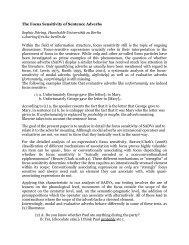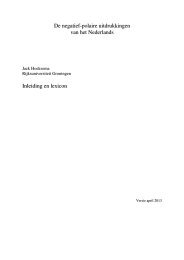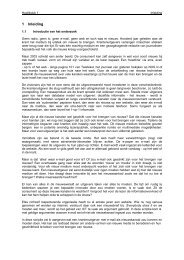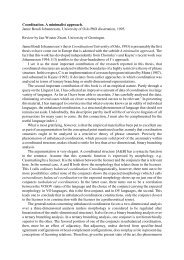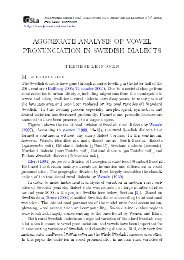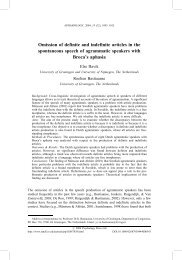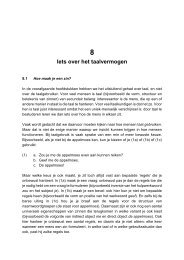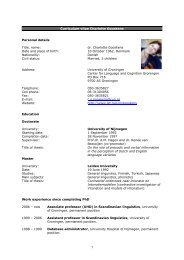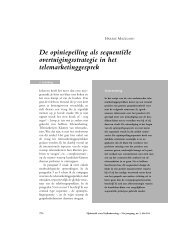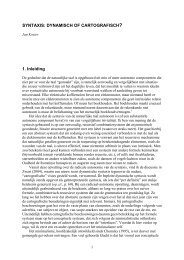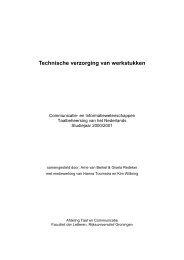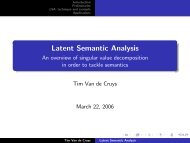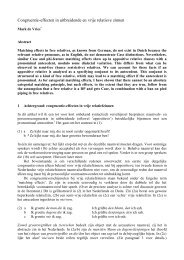Quantification in Spanish-speaking Children with Language ...
Quantification in Spanish-speaking Children with Language ...
Quantification in Spanish-speaking Children with Language ...
Create successful ePaper yourself
Turn your PDF publications into a flip-book with our unique Google optimized e-Paper software.
the neurological (Troiani, Peelle, Clark & Grossman, 2009) and behavioral level<br />
for adult process<strong>in</strong>g (among many others, Cumm<strong>in</strong>s & Katsos, 2010; Hackl,<br />
2009; Szymanik & Zajenkowski, 2010) and for child acquisition (e.g., Hanlon,<br />
1988; Katsos, Andrés Roqueta, Estevan & Cumm<strong>in</strong>s, 2011). Based on these<br />
studies, the follow<strong>in</strong>g hypotheses can be deduced from the mean<strong>in</strong>g of the<br />
specific expressions that we study.<br />
Hypothesis 1 relates to polarity and the fact that negation is a l<strong>in</strong>guistically<br />
and psychol<strong>in</strong>guistically marked function (Just & Carpenter, 1971). We could<br />
therefore expect that children’s rates of successful comprehension will be higher<br />
<strong>with</strong> positive quantifiers (‘all’, ‘some’) than negative ones (‘none’,<br />
‘some…not’).<br />
Hypothesis 2 relates to totality and the fact that quantifiers whose reference<br />
set is the maximum possible set appear earlier <strong>in</strong> acquisition over quantifiers<br />
whose reference set is a portion of the potential reference set (Hanlon, 1988).<br />
We could therefore expect that children’s rates of successful comprehension will<br />
be higher <strong>with</strong> universal (‘all’, ‘none’) than existential quantifiers (‘some’,<br />
‘some…not’).<br />
Hypothesis 3 relates to semantic complexity and the fact that while both<br />
‘some’ and ‘most’ refer to an under-specified portion of the total, ‘most’<br />
stipulates an additional constra<strong>in</strong>t, namely that this portion be more than half (<strong>in</strong><br />
fact the mean<strong>in</strong>g of ‘most’ is likely to be richer than ‘more than half’, but this<br />
rough paraphrase suffices for stat<strong>in</strong>g this hypothesis; see Hackl, 2009; Pietroski,<br />
Lidz, Hunter, & Halberda, 2009). It is expected that children’s rates of<br />
successful comprehension will be higher <strong>with</strong> existential ‘some’ than<br />
proportional ‘most’.<br />
Turn<strong>in</strong>g to the use of quantifiers, our f<strong>in</strong>al hypothesis, 4, relates to<br />
<strong>in</strong>formativeness and truth. Young children seem to make extensive use of<br />
pragmatic pr<strong>in</strong>ciples for word learn<strong>in</strong>g and disambiguation (Clark, 1990), and<br />
they are also aware that under- and over-<strong>in</strong>formative utterances are not optimal<br />
(Davies & Katsos, 2010; Katsos & Bishop, 2011; Katsos & Smith, 2010).<br />
Nevertheless young children do not consider violations of <strong>in</strong>formativeness to be<br />
as grave as violations of logical truth, and do not categorically reject under<strong>in</strong>formative<br />
utterances (e.g., Guasti, Chierchia, Cra<strong>in</strong>, Foppolo, Gualm<strong>in</strong>i &<br />
Meroni, 2005; Noveck, 2001; Papafragou & Musol<strong>in</strong>o, 2003). We could<br />
therefore expect children’s rates of successful comprehension to be higher <strong>with</strong><br />
true-and-<strong>in</strong>formative or patently false utterances than <strong>with</strong> true-but-under<strong>in</strong>formative<br />
utterances (for ‘some’, ‘some…not’, and ‘most’).<br />
Crucially, the prediction is that the four patterns described above will obta<strong>in</strong><br />
<strong>in</strong> every language <strong>in</strong> our sample, precisely because these patterns rely on crossl<strong>in</strong>guistically<br />
similar properties of the mean<strong>in</strong>g and use of quantifiers.<br />
4.2. Predictions based on language-specific features<br />
Moreover, it is likely that language-specific lexical and syntactic properties<br />
of quantified utterances will affect the pattern of acquisition. For example, <strong>in</strong><br />
6



